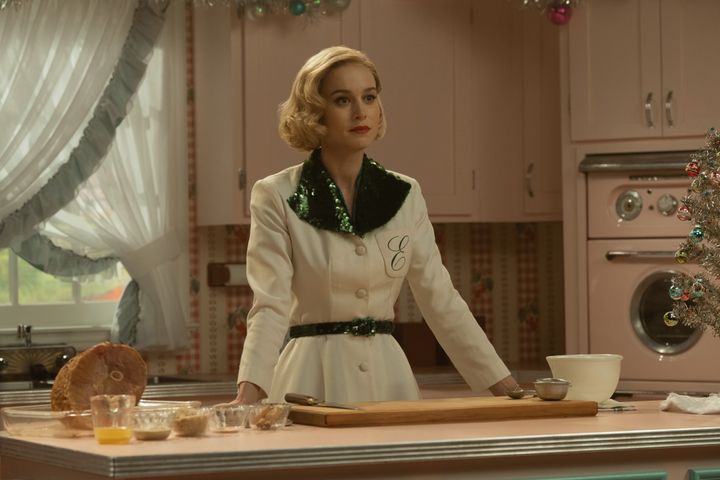
“Children set the table. Your mother needs a moment for herself,” is the signature sign-off of Elizabeth Zott (Brie Larson) on her Julia Child-esque television program, “Supper at Six.”
Apple TV+’s eight-episode series, “Lessons in Chemistry,” is based on Bonnie Garmus’ bestselling book and explores Zott’s journey from chemist to host of a smash-hit cooking show during the 1950s and early 1960s.
As a fan of the book, I’ve long loved Zott’s trademark line because I feel the need for time to myself deep in my bones, in the exhaustion I carry around all day while caring for a 5- and 3-year-old who no longer nap and rarely stop moving. So, when the house is finally quiet, and I turn on the TV at night, I want to feel like the fictional women sitting in front of their sets to watch “Supper at Six,” like I’m tuning into something worthwhile, something that will give me both the respite from and strength for the mothering that must happen tomorrow.
“Lessons in Chemistry” tries to do this. With Apple’s trademark aesthetics and crisp cinematography, the show immediately draws viewers into the mid-20th century setting ― a time when men dominated the workplace, especially fields such as chemistry, and women were relegated to the traditionally feminine work of housework and caretaking.
Enter Elizabeth Zott, a woman with a master’s in chemistry fighting to research abiogenesis but unable to because she is only a lab tech and never received her Ph.D. Despite the setbacks, including a violent sexual assault, Elizabeth is determined to be a scientist and continue her research, even if it involves stealing supplies from other well-funded labs, like that of the brilliant Calvin Evans (Lewis Pullman).
However, despite the show’s intriguing premise, good acting and immersive setting, it falls flat, especially when compared to other period pieces that also examine the complexities of sexism and gender and marriage (such as “Mad Men” or “The Marvelous Mrs. Maisel”). I think it will also be disappointing for fans of the book — even those, like me, who enjoyed seeing Garmus’ world brought to life.
On the surface, the show seems to align closely with the novel’s plot. The only major divergence is the expansion of the character who plays her neighbor, Harriet Sloane (Aja Naomi King), and Sloane’s fight against the intended route of a freeway that will destroy her historically Black neighborhood (a subplot that is a high point of the show but under-explored).
However, while the show explores the same 1950s gender dynamics and rampant sexism that prevent Zott from achieving everything of which she is intellectually capable of, it does so with a heavier hand and lazier storytelling. The result is that despite Larson’s impeccable acting, her character has less to work with than the novel’s version of Zott.
This is best evidenced in her job at Hastings laboratories and her romance with famous scientist Evans. In the book, Zott is a chemist pursuing her own research, but in the show, she is a lab tech with even less power and fewer resources. Within the first 15 minutes of Episode 1, Zott encounters every sexist cliché you can imagine in a 1950s workplace: She’s called “honey” or “sweetheart,” asked to make coffee, told to smile, and mistaken for a secretary by Evans. Sexist plot devices that aren’t even present in the book also show up: She’s required to enter the Miss Hastings Pageant. The overt sexism is so stereotypical that it becomes trope-like, functioning as an indictment of the script instead of an indictment of the period.
However, while the explicit sexism is grating, what’s even more disappointing is the romance between Zott and Evans. Larson and Pullman have great on-screen chemistry and a stronger working partnership in the book, but Zott does not have the same agency that the show is fighting so hard to prove she has because she joins Evans’ lab.
In the book, she is defined by her “grit,” by her refusal to let sexism stop her from conducting her potentially groundbreaking research, and does not work in his lab because she wants to maintain her autonomy. So, while in the show it is fun to watch her work alongside Pullman, it is disappointing to see her become so dependent on him. This decision proves even more ominous at the end of the second episode when Evans leaves for a jog and is hit by a car.
The show’s over-simplification of the book’s themes is best evidenced when Zott tells Evans that she doesn’t want to get married or have kids: “[a] woman has to make a choice, does she want to have children or does she want to do anything else.” The rest of the six episodes are set up to explore this conflict. After Evans’ death, a pregnant Zott is left alone to figure out what it means to be a mother and a scientist, and how, or if it is even possible, to balance those two identities.
This should make it compelling, fresh television, especially in a post-Dobbs world where more and more women are being forced into motherhood. The fact that the show doesn’t accomplish this is a missed opportunity, one that makes “Lessons in Chemistry” enjoyable to watch but not novel.
Yes, it’s fun to watch Elizabeth Zott tell women to take a moment for themselves, but, two episodes in, it is apparent that this screen adaptation may not be worthy of that time.
The first two episodes of “Lessons in Chemistry” were released Friday on Apple TV+, and a new episode will be released weekly until Nov. 24.
